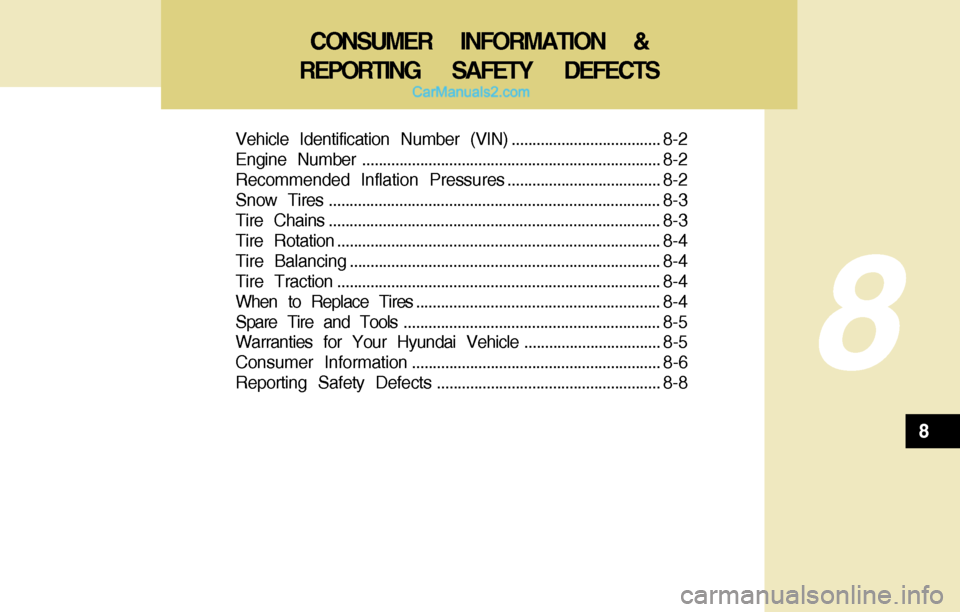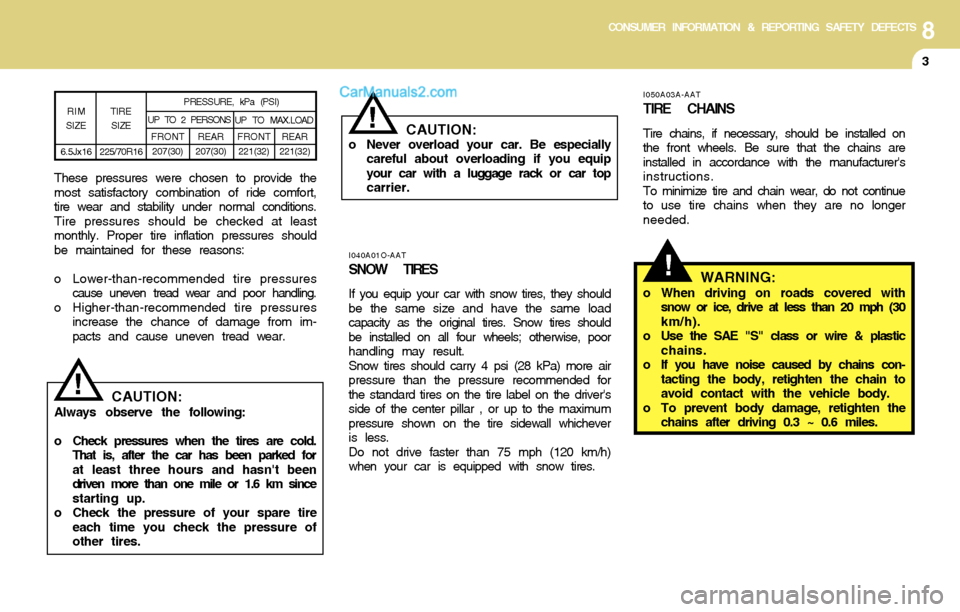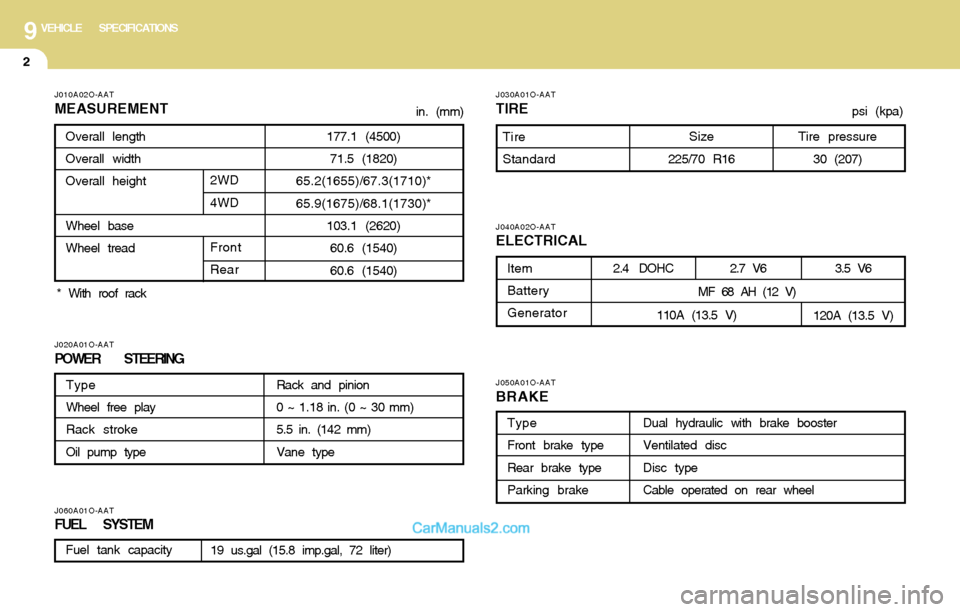2004 Hyundai Santa Fe tire pressure
[x] Cancel search: tire pressurePage 219 of 253

6DO-IT-YOURSELF MAINTENANCE
25HEADLIGHT AIMING ADJUSTMENT
G290B01O-AAT
Adjustment After Headlight Assembly
Replacement
If the vehicle has had front body repair and the
headlight assembly has been replaced, the
headlight aiming should be checked using an
aiming chart as shown in the illustration. Turn on
the headlight switch. (Low Beam Position)
1 . Adjust headlights so that main axis of light is
parallel to center line of the body and is
aligned with point "P" shown in the illustration.
2 . Dotted lines in the illustration show the center
of headlights.
G290A03O
L
W
H
H
Cut-off line
Ground line
"P"
Horizontal line
Vertical line
!
6 . Draw the vertical line (through the center of
each headlight beam pattern) and the hori-
zontal line (through the center of each head-
light beam pattern) on the aiming screen.
And then, draw a parallel line at 0.8 in. (21
mm) under the horizontal line.
7. Adjust each cut-off line of the low beam to the
parallel line with a phillips screwdriver -
VERTICAL AIMING.
WARNING:Horizontal aiming should be adjusted by
an authorized Hyundai dealer.
G290A01O
Vertical
aiming
G290A02O-AAT
Before performing aiming adjustment, make
sure of the following.
1 . Keep all tires inflated to the correct pressure.
2 . Place the vehicle on level ground and press
the front bumper & rear bumper down sev-
eral times.
Place vehicle at a distance of 118 in. (3m)
from the test wall.
3 . See that the vehicle is unloaded (except for
full levels of coolant, engine oil and fuel, and
spare tire, jack, and tools). Have the driver
or equivalent weight placed in driver's seat.
4 . Clean the head light lenses and turn on the
headlights (Low beam).
5 . Open the hood.
Page 234 of 253

Vehicle Identification Number (VIN).................................... 8-2
Engine Number........................................................................ 8-2
Recommended Inflation Pressures..................................... 8-2
Snow Tires................................................................................ 8-3
Tire Chains................................................................................ 8-3
Tire Rotation.............................................................................. 8-4
Tire Balancing........................................................................... 8-4
Tire Traction .............................................................................. 8-4
When to Replace Tires........................................................... 8-4
Spare Tire and Tools.............................................................. 8-5
Warranties for Your Hyundai Vehicle ................................. 8-5
Consumer Information............................................................ 8-6
Reporting Safety Defects...................................................... 8-8
CONSUMER INFORMATION &
REPORTING SAFETY DEFECTS
8
8
Page 235 of 253

8CONSUMER INFORMATION & REPORTING SAFETY DEFECTS
2TIREENGINE NUMBERVEHICLE IDENTIFICATION
NUMBER (VIN)
I030A02S-AAT
RECOMMENDED INFLATION PRES-
SURES
I020A01A-AAT
TIRE INFORMATION
The tires supplied on your new Hyundai are
chosen to provide the best performance for
normal driving.
I010B01A-AAT I010A02A-AAT
The vehicle identification number (VIN) is the
number used in registering your car and in all
legal matters pertaining to its ownership, etc. It
can be found in four different places on your car:
1. On the bulkhead between the engine and
passenger compartments.
2 . On the left top side of the instrument panel
where it can be seen by looking down through
the windshield.
3. Door edge post.
4 . On the lower side of the center pillar outer
panel.
The engine number is stamped on the engine
block as shown in the drawing.The tire label located on the driver's side of the
center pillar outer panel gives the tire pressures
recommended for your vehicle.
I010A01O
I030A01O I010B01O
2.4 DOHC2.7 V6
I010B01L
3.5 V6
23
14
Page 236 of 253

8CONSUMER INFORMATION & REPORTING SAFETY DEFECTS
3
!
I040A01O-AAT
SNOW TIRES
If you equip your car with snow tires, they should
be the same size and have the same load
capacity as the original tires. Snow tires should
be installed on all four wheels; otherwise, poor
handling may result.
Snow tires should carry 4 psi (28 kPa) more air
pressure than the pressure recommended for
the standard tires on the tire label on the driver's
side of the center pillar , or up to the maximum
pressure shown on the tire sidewall whichever
is less.
Do not drive faster than 75 mph (120 km/h)
when your car is equipped with snow tires.
RIM
SIZETIRE
SIZEPRESSURE, kPa (PSI)
UP TO 2 PERSONS
UP TO MAX.LOAD
FRONT
207(30)REAR
207(30)FRONT
221(32)REAR
221(32)
225/70R16 6.5Jx16
These pressures were chosen to provide the
most satisfactory combination of ride comfort,
tire wear and stability under normal conditions.
Tire pressures should be checked at least
monthly. Proper tire inflation pressures should
be maintained for these reasons:
o Lower-than-recommended tire pressures
cause uneven tread wear and poor handling.
o Higher-than-recommended tire pressures
increase the chance of damage from im-
pacts and cause uneven tread wear.
CAUTION:Always observe the following:
o Check pressures when the tires are cold.
That is, after the car has been parked for
at least three hours and hasn't been
driven more than one mile or 1.6 km since
starting up.
o Check the pressure of your spare tire
each time you check the pressure of
other tires.o Never overload your car. Be especially
careful about overloading if you equip
your car with a luggage rack or car top
carrier.
CAUTION:!
!
I050A03A-AAT
TIRE CHAINS
Tire chains, if necessary, should be installed on
the front wheels. Be sure that the chains are
installed in accordance with the manufacturer's
instructions.
To minimize tire and chain wear, do not continue
to use tire chains when they are no longer
needed.
WARNING:o When driving on roads covered with
snow or ice, drive at less than 20 mph (30
km/h).
o Use the SAE "S" class or wire & plastic
chains.
o If you have noise caused by chains con-
tacting the body, retighten the chain to
avoid contact with the vehicle body.
o To prevent body damage, retighten the
chains after driving 0.3 ~ 0.6 miles.
Page 237 of 253

8CONSUMER INFORMATION & REPORTING SAFETY DEFECTS
4
I080A01A-AAT
TIRE TRACTION
Tire traction can be reduced if you drive on worn
tires, tires that are improperly inflated or on
slippery road surfaces. Tires should be re-
placed when tread wear indicators appear. To
reduce the possibility of losing control, slow
down whenever there is rain, snow or ice on the
road.
I070A01A-AAT
TIRE BALANCING
A tire that is out of balance may affect handling
and tire wear. The tires on your Hyundai were
balanced before the car was delivered but may
need balancing again during the years you own
the car.
Whenever a tire is dismounted for repair, it
should be rebalanced before being reinstalled
on the car.
I090A01A-AAT
WHEN TO REPLACE TIRES
The original tires on your car have tread wear
indicators. The tread wear indicators appear
when the tread depth is 0.06 in. (1.6 mm). The
tire should be replaced when these appear as
a solid bar across two or more grooves of the
tread. Always replace your tires with those of
the recommended size. If you change wheels,
the new wheel's rim width and offset must meet
Hyundai specification.
HGK248
Wear indicator 0.06 in. (1.6 mm)
!
I060A01O-AAT
TIRE ROTATION
Tires should be rotated every 7,500 miles
(12,000 km). If you notice that tires are wearing
unevenly between rotations, have the car
checked by a Hyundai dealer so the cause may
be corrected.
After rotating, adjust the tire pressures and be
sure to check wheel nut torque.
CAUTION:Do not mix bias-ply and radial-ply under
any circumstances. This may cause dan-
gerous handling characteristics.
HA1409Spare tire
Page 243 of 253

9VEHICLE SPECIFICATIONS
2
J060A01O-AATFUEL SYSTEM
J050A01O-AAT
BRAKE
J040A02O-AATELECTRICAL
J030A01O-AAT
TIRE
J020A01O-AATPOWER STEERING
J010A02O-AAT
MEASUREMENT
177.1 (4500)
71.5 (1820)
65.2(1655)/67.3(1710)*
65.9(1675)/68.1(1730)*
103.1 (2620)
60.6 (1540)
60.6 (1540) Overall length
Overall width
Overall height
Wheel base
Wheel tread
Front
Rear
Type
Wheel free play
Rack stroke
Oil pump typeRack and pinion
0 ~ 1.18 in. (0 ~ 30 mm)
5.5 in. (142 mm)
Vane type
Tire pressure
30 (207)Tire
Standard
Item
Battery
Generator2.4 DOHC2.7 V6
110A (13.5 V)
Dual hydraulic with brake booster
Ventilated disc
Disc type
Cable operated on rear wheel Type
Front brake type
Rear brake type
Parking brake
19 us.gal (15.8 imp.gal, 72 liter)psi (kpa)
Size
225/70 R16Fuel tank capacity
3.5 V6
120A (13.5 V)
MF 68 AH (12 V) 2WD
4WD* With roof rackin. (mm)
Page 251 of 253

10INDEX
5
R
Rear Seat
Adjusting seatback angle .............................................................1-16
Folding rear seatback and seat cushion ....................................1-17
Rear Window Defroster Switch ........................................................1-52
Reporting Safety Defects................................................................... 8-8
Roof Rack .........................................................................................1-70
S
Seat
Front.............................................................................................1-11
Rear..............................................................................................1-16
Seat warmer.................................................................................1-16
Seat Belts
3-point system .............................................................................1-21
2-point static type .........................................................................1-23
Pretensioner seat belt ..................................................................1-29
Adjusting your seat belt..................................................... 1-23, 1-24
Care of seat belts .........................................................................1-20
Precautions..................................................................................1-18
Shop Manual ........................................................................................ 8-5
Sound
Brake pad warning sound ............................................................1-45
Parking start warning sound ........................................................1-45
Spark Plugs .......................................................................................6-10
Spectacle Case .................................................................................1-60
Speedometer.....................................................................................1-47
Starting Procedure .............................................................................. 2-5Steering Wheel Free play .................................................................6-19
Steering Wheel Tilt Lever ..................................................................1-74
Stereo Sound System .......................................................................1-94
Sunroof..............................................................................................1-56
Sun Visor ...........................................................................................1-73
T
Tachometer.......................................................................................1-47
Tail Gate ............................................................................................1-67
Tail gate window ...........................................................................1-68
Theft-Alarm System............................................................................ 1-8
Tires
Balancing ........................................................................................ 8-4
Chains ............................................................................................ 8-3
Changing a flat tire ......................................................................... 3-6
If you have a flat tire ....................................................................... 3-6
Information ...................................................................................... 8-2
Pressure......................................................................................... 8-2
Replacement.................................................................................. 8-4
Rotation .......................................................................................... 8-4
Snow tires ....................................................................................... 8-3
Spare tire ........................................................................................ 3-5
Traction.......................................................................................... 8-4
Towing
A trailer (or vehicle) ......................................................................2-26
Emergency...................................................................................3-12
If your car must be towed ............................................................3-10
Traction Control System ....................................................... 2-15 ~ 2-18
Page 253 of 253

Seoul KoreaPrinting: MAR. 16, 2004
Publication No.: A26O-EU43X
Printed in Korea
SERVICE STATION INFORMATION
FUEL:
UNLEADED gasoline only
Pump Octane Rating of 87 (Research Octane Number 91) or higher.
FUEL TANK CAPACITY
US.gal (Imp.gal., liter) 19 (15.8, 72)
TIRE PRESSURE:
See the label on the driver's side of the center pillar outer panel.
OTHER TIRE INFORMATION:
See pages 8-2 through 8-7.
HOOD RELEASE:
Pull handle under left side of dash.
ENGINE OIL:
API grade SH, SG or SG/CD multigrade and fuel efficient oil. Use SAE
10W-30, 10W-40 or 10W-50 if normal temperatures are above -10°F
(-23°C). For other viscosity recommendations, see page 6-6 or 9-4.
MANUAL TRANSAXLE:
HYUNDAI GENUINE PARTS MTF 75W/90 (API GL-4) Oil level
should be up to filler-bolt hole in housing beside differential.
AUTOMATIC TRANSAXLE:
Apply the parking brake, with the engine running, shift the selector lever
through all ranges and return to “N” (Neutral) position. Then check the
level of fluid on the dipstick. Use only HYUNDAI GENUINE ATF
available at your dealer or DIAMOND ATF SP-III or SK ATF SP-III.
QUICK INDEX
o Car will not start ....................................................................... 3-2
o Flat tire ..................................................................................... 3-6
o Warning light/chime comes on ................................... 1-42 ~ 1-45
o Engine overheats ...................................................................... 3-4
o Towing of your vehicle ........................................................... 3-10
o Starting the engine ................................................................... 2-5
o Driving tips for first 1,200 miles (2,000 km) .......................... 1-3
o Scheduled maintenance ............................................................ 5-4
o Reporting safety defects ........................................................... 8-8